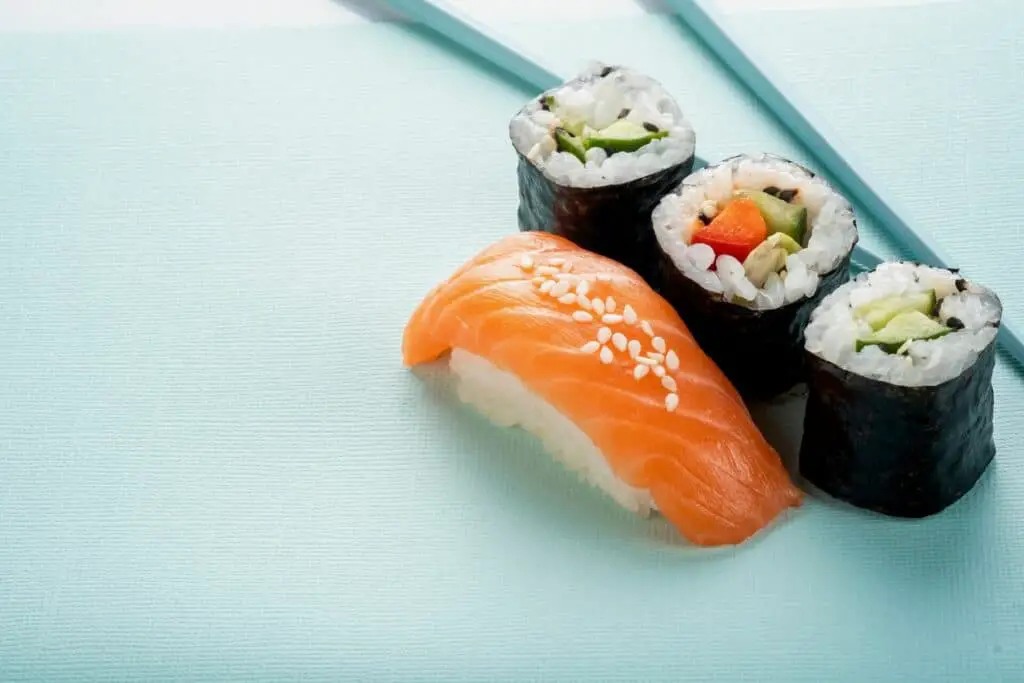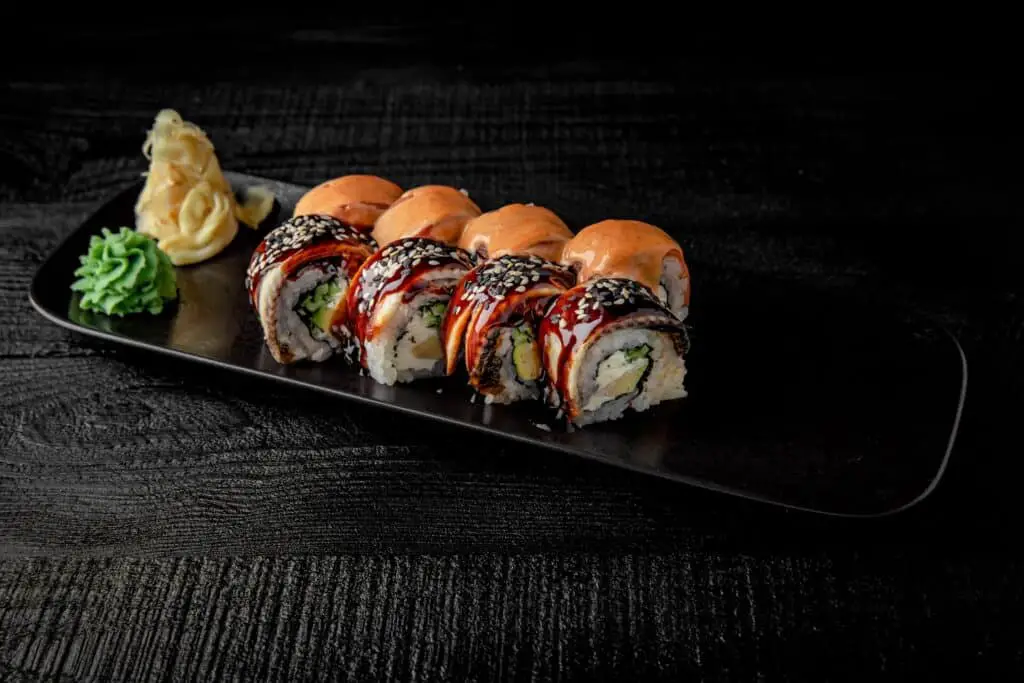Whenever I go out for sushi, I can’t help but wonder how much it all weighs. It seems like a lot of food, especially when you order the big rolls. But is it really that heavy? Curious about the answer, I did some research and found out just how much sushi weighs on average.
How much does sushi weigh? The weight of a sushi piece depends on the type of sushi. One piece of sushi cut from a maki roll can weigh between 30-50 g. Nigiri also typically weighs about 30 g, and one sashimi piece can weigh about 20-60 g, depending on the thickness of the fish slice.


Sushi is a pretty broad term – it covers a few different types of food, which obviously look different and thus weigh differently. In this text, I’ve written about the most commonly consumed types of sushi and their weight, so you can figure out how much sushi you actually need to order and not have tons of rolls ending up as waste. Keep reading for some great info.
How Much Does Sushi Weigh? Here’s All You Need to Know About the Weight of Different Types of Sushi
When you see a piece of sushi, it looks tiny and weightless – we all think we can eat a million pieces of this delicious Japanese food. Personally, I’ve had issues with limiting my sushi intake, but once you learn how much you actually consume with a single roll, it becomes easier to control yourself. So, this is the reason why I wanted to share a bit about the weight of sushi – to help you understand more about what you eat, and to show you approximately how much you should order for your regular dinner.
Of course, there are so many different sushi recipes, and not all of them have the same measurements, so you can find plenty of variations when it comes to the size and weight of sushi. However, I’ve done some research and found the most common serving sizes you can expect when you order a few rolls from your favorite restaurant. In this text, I’ve limited myself to talking about the following types of sushi:
- Maki rolls,
- Futomaki,
- Temaki rolls,
- Nigiri,
- Sashimi.
How Big Is an Average Sushi Roll – Maki, Futomaki, and Temaki?
Maki rolls consist of vegetables and fish, covered with a layer of rice and nori (dried seaweed), which are then rolled with a bamboo mat (also known as makisu). Each piece weighs about 30-50 g, depending on the size of the roll. One roll is usually cut into 6 or 8 pieces.
Futomaki is basically a bigger version of maki, with up to 10 ingredients. Translated from Japanese, futomaki means “fat rolled sushi” – it is usually 5-6 cm thick. Futomaki is almost twice as big as maki.
Temaki is cone-shaped hand-rolled sushi – it consists of nori, rice, and various ingredients that spill from the wider end of the cone. It’s about 10 cm long, and obviously, the weight of temaki will depend on the ingredients that were put in the cone.
How Heavy Is a Piece of Sashimi?
Sashimi is thinly sliced raw fish that’s served on its own. The only thing that you can add is soy sauce, of course. Now, when we look at the weight of sashimi, it’s clear that it will depend on how thick your slices are. Most chefs make sashimi that’s 0.5-2 ounces. Most commonly, it’s 1 ounce – that’s about 30 g. I’ve seen sashimi anywhere from 20-60 g, so it all depends on your preferences.
How Much Does a Piece of Nigiri Weigh?
Nigiri consists of a carefully shaped rice ball topped with a slice of raw fish. Let me note that the fish has to be shaped precisely to fit the rice ball – it’s not as simple to make as it sounds. The size of nigiri will depend on the amount of fish you decide to use, but typically, one piece of this deliciousness is about 30 g.

Will Eating Sushi Help You Lose Weight?
I know what you’re thinking – this is probably great for losing weight because it weighs so little (at least if you can control yourself when ordering). When you know that adults are supposed to consume no more than 2 or 3 rolls of sushi per week, it also looks like a great option for your diet. You won’t eat much, so it shouldn’t be too caloric, right? Well, it all depends – sushi can be low on calories, but it can also have way too many calories for a single meal.
While we can’t deny that it is very healthy, the problem lies in the type of sushi you order. Raw fish and other seafood are extremely healthy ingredients – all those proteins and great omega-3 acids, remember? Sashimi is especially great if you want to pay attention to your diet – nothing but healthy fish.
But don’t forget that your favorite maki rolls contain zillion other ingredients that can be very caloric – so sushi can be both great and horrible for dieting, depending on what you choose to eat. To make this a bit clearer, I’ve gathered the info on calories for a few popular dishes per 100 g. Keep in mind that 100 g is usually 2 or 3 pieces of sushi.
| Sushi | Calories per 100 g |
| Salmon sashimi | 127 |
| Tuna nigiri | 117 |
| Spider roll | 214 |
| California roll | 93 |
| Philadelphia roll | 170 |
| Cucumber roll | 78 |
| Salmon avocado roll | 179 |
Sushi Might Not Weigh Much, But It Contains Plenty of Nutritional Substances (and Calories)
As you can see, sushi has two faces. One is a healthy food with clean ingredients full of proteins and omega-3, and the other is extremely caloric food with various ingredients that add up to a bigger intake than we would like. It all depends on what kind of sushi you choose, so if you’re worried about your calories, make sure to double-check which rolls you will eat!